Key takeaways:
- Child safeguarding principles emphasize the importance of listening to children and empowering them to understand their rights.
- Effective policy implementation requires clear communication, sufficient resources, and continuous engagement to translate theoretical frameworks into actionable practices.
- Involving all stakeholders in the process encourages ownership and acceptance, while simplifying policy language enhances understanding and buy-in.
- Ongoing feedback and collaboration with community organizations are crucial for refining safeguarding initiatives and ensuring they remain effective and relevant.

Understanding child safeguarding principles
Understanding child safeguarding principles is essential for creating environments where children feel safe and protected. I remember my first encounter with safeguarding policies; I was struck by how often they highlighted the importance of listening to children. Why is this crucial? Children often communicate their needs and fears in subtle ways, and it’s vital to cultivate a space where they feel empowered to speak up.
One of the key principles I’ve learned is the balance between protection and empowerment. For instance, during a workshop I co-facilitated, a participant shared a story about a child who felt confident enough to report inappropriate behavior because they understood their rights. This brought home to me how crucial it is for children to not only be protected but also to understand their own agency within these safeguarding frameworks. How do we ensure that every child recognizes they have a voice?
Emphasizing the principle of a child-centered approach is another vital aspect that has always resonated with me. When I was involved in developing policies, we prioritized the perspectives of children and young people, listening to their insights, which truly shaped our strategies. It creates a deeper connection within our communities when children see that their views matter and that policies are not just top-down decrees. The moment we realize that safeguarding is not just about rules, but about fostering meaningful relationships, we truly start to understand the essence of safeguarding principles.
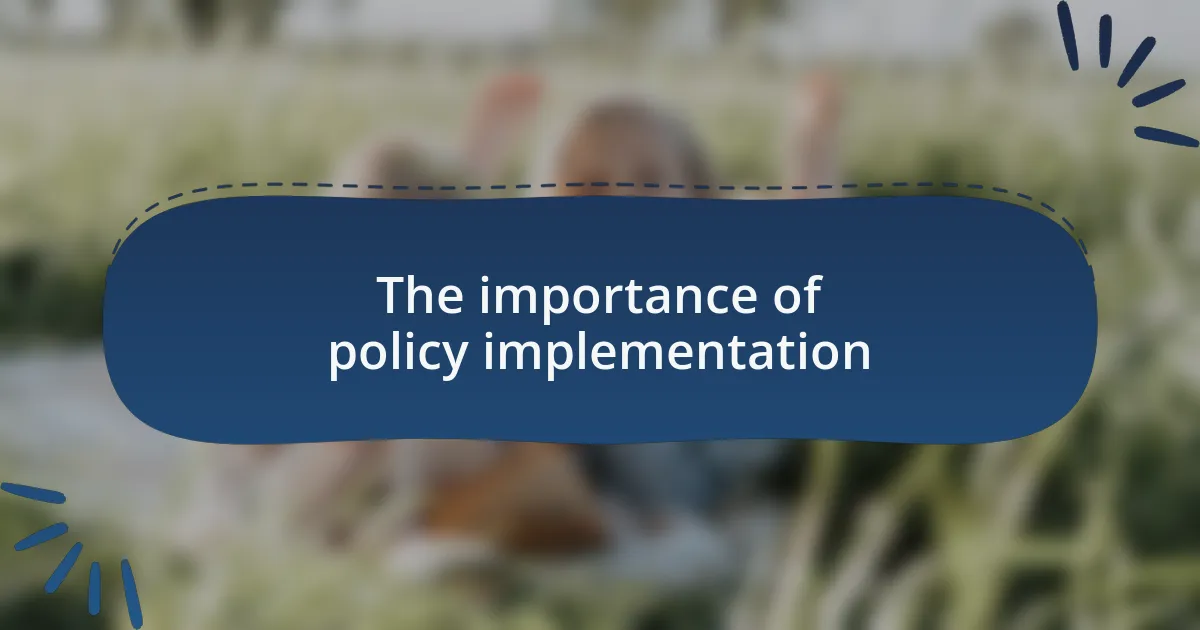
The importance of policy implementation
Policy implementation is where the theoretical meets the practical, and its significance cannot be overstated. I recall a time when I was part of a team rolling out a new safeguarding policy at a local community center. Initially, we had a great plan, but without proper implementation, it fell flat. This experience underscored for me that having a policy on paper is just a starting point; it’s the actions that follow that truly protect children.
When I reflect on the importance of implementing policies effectively, I think about the ripple effect it creates within a community. For instance, in my own experience, I witnessed how a well-implemented policy not only fostered trust among parents but also encouraged children to engage more openly with the staff. It made me realize that when policies are enacted thoughtfully, the community feels more secure, and everyone benefits.
I’ve often asked myself, what does it mean to turn good intentions into real change? In my view, it’s about accountability. When organizations commit to seeing policies through, they send a powerful message about their dedication to child welfare. I’ve participated in evaluations where we revisited these policies, discussing what worked and what didn’t, and it was enlightening to see how minor adjustments could lead to significant improvements in safeguarding practices. Implementing policy is not merely a task; it’s an ongoing journey that shapes a culture of safety and care.
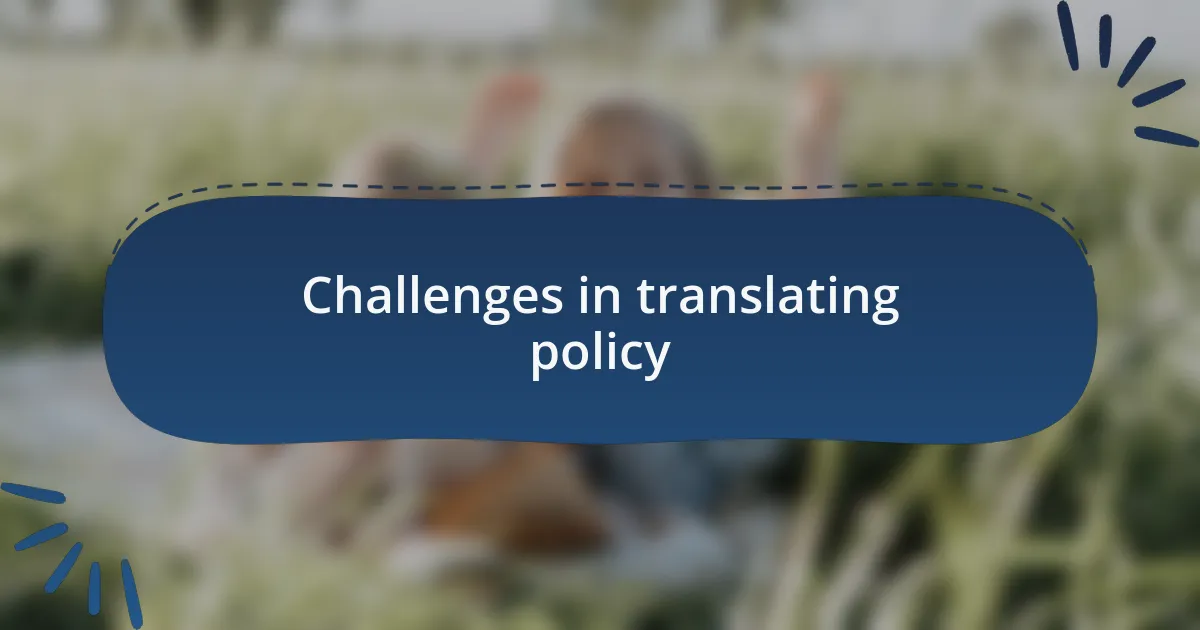
Challenges in translating policy
Translating policy into action often reveals unexpected obstacles. I remember facing resistance from staff who were used to a certain way of doing things. It struck me how deeply ingrained habits can blind us to the benefits of new policies, creating a barrier that needs careful navigation.
One significant challenge I encountered was the gap between policy language and on-the-ground practice. In a workshop, a staff member expressed confusion over a complex policy document, saying, “How do we translate this into something we can actually use?” This moment highlighted the need for clear communication and practical examples—without these, policies risk becoming mere words rather than actionable guidelines.
Moreover, resource limitations can severely hinder the translation of policy into practice. I once worked with a team eager to implement important child safeguarding measures, but our budget constraints meant we struggled to provide necessary training. How do we prioritize safeguarding when we can’t equip our team adequately? This experience taught me that effective policy implementation requires not just commitment but also adequate resources and support for staff to thrive in their roles.
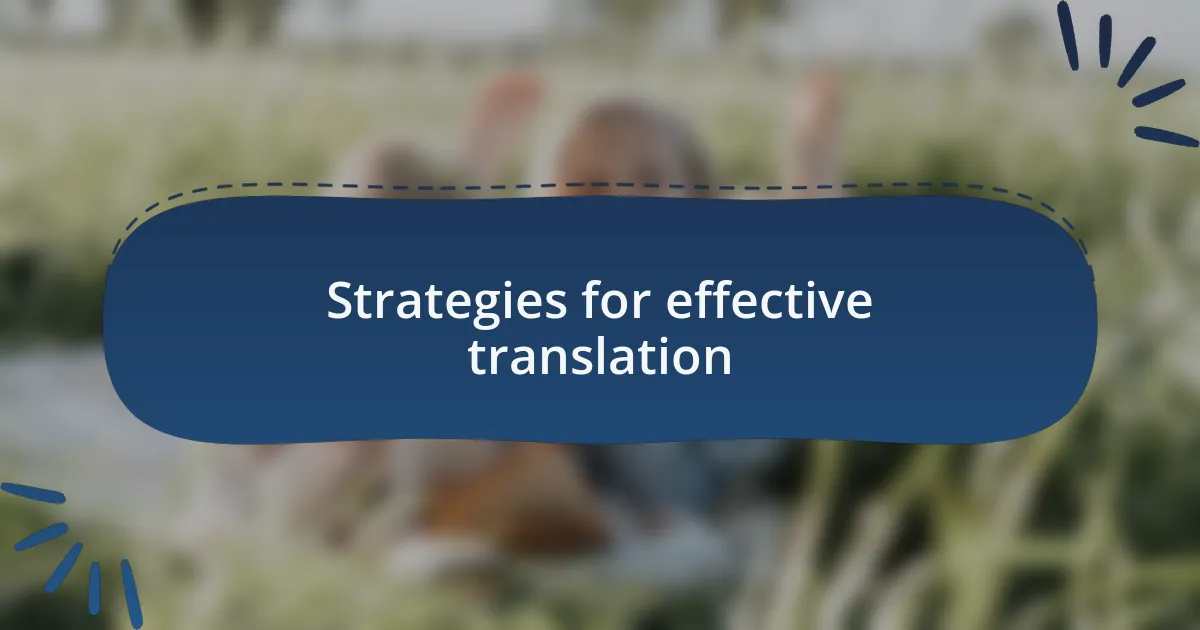
Strategies for effective translation
One effective strategy for translating policy into action is engaging all stakeholders early in the process. I recall a time when I organized a series of collaborative meetings that included staff, parents, and even young people. It was empowering to see how their input not only clarified the policies but also motivated everyone to embrace the changes. Isn’t it amazing how inclusion can transform skepticism into enthusiasm?
Another crucial element is the simplification of policy language. During a project focused on child safeguarding, I made it a priority to turn complex terminology into relatable, everyday language. I remember one team member telling me how accessible the revised materials were, which helped them feel more confident discussing these policies in their classrooms. It’s a small shift but can significantly impact comprehension and buy-in.
Finally, continuous training and support are key to long-term success. I once facilitated regular check-ins where staff could discuss their challenges and share successes. This not only reinforced the policy but also fostered a culture of learning and adaptation within our organization. Who wouldn’t want to work in an environment where growth and support are part of the daily routine?
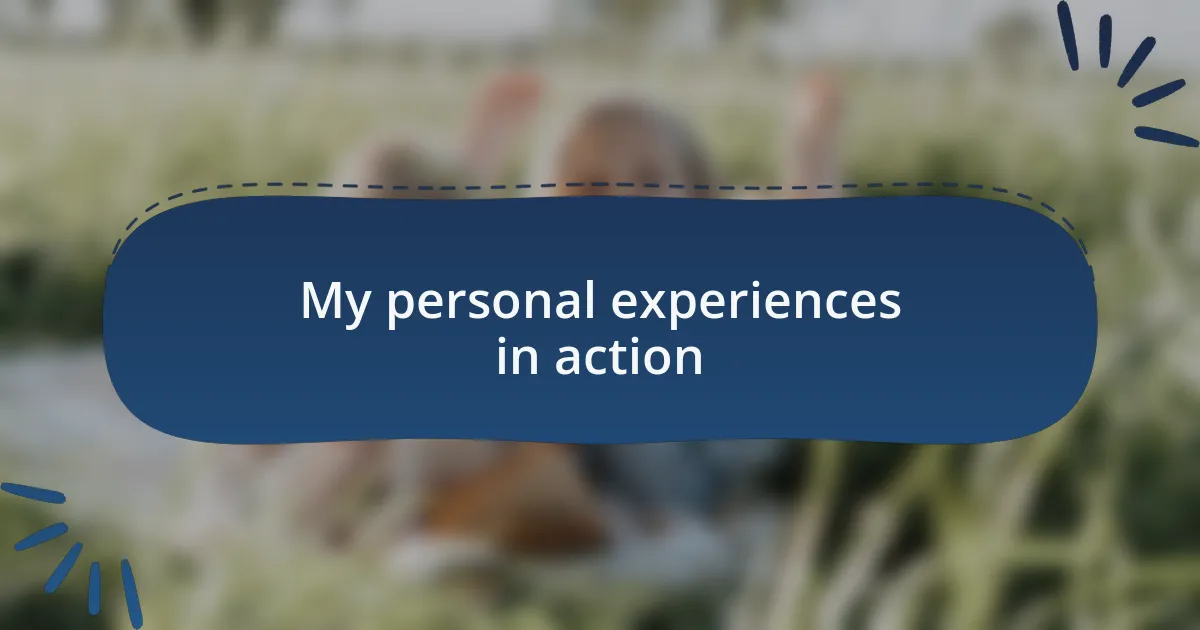
My personal experiences in action
In my journey translating policy into action, I’ve often found myself immersed in real-world scenarios that shaped my perspective. I vividly remember a case where a newly implemented safeguarding measure faced resistance; staff felt overwhelmed and unsure. Instead of pushing through, I invited them to a casual brainstorming session over coffee. The change in atmosphere allowed for open dialogue, and to my surprise, their insights led to adjustments that could truly resonate with their experiences. Isn’t it fascinating how a simple shift in setting can unlock creativity and collaboration?
I also learned the value of sharing personal stories during training sessions. One memorable moment was when I shared a humble experience from my own childhood, relating to the importance of feeling safe and protected. The room became still, and I could feel the emotional connection as colleagues began to share their stories too. These moments are powerful reminders that safeguarding is ultimately about the human experience. How often do we find that personal narratives can open hearts and minds?
Moreover, my experiences highlighted the necessity of follow-through after the initial implementation of any policy. I recall a time when an initiative seemed promising, but without ongoing engagement, it quickly faded into the background. I decided to create a monthly community feedback forum, inviting everyone to share their thoughts and progress. The resulting discussions were not only enlightening but also invigorating, reigniting the passion for our mission. Isn’t it remarkable how staying connected can keep our efforts alive and thriving?
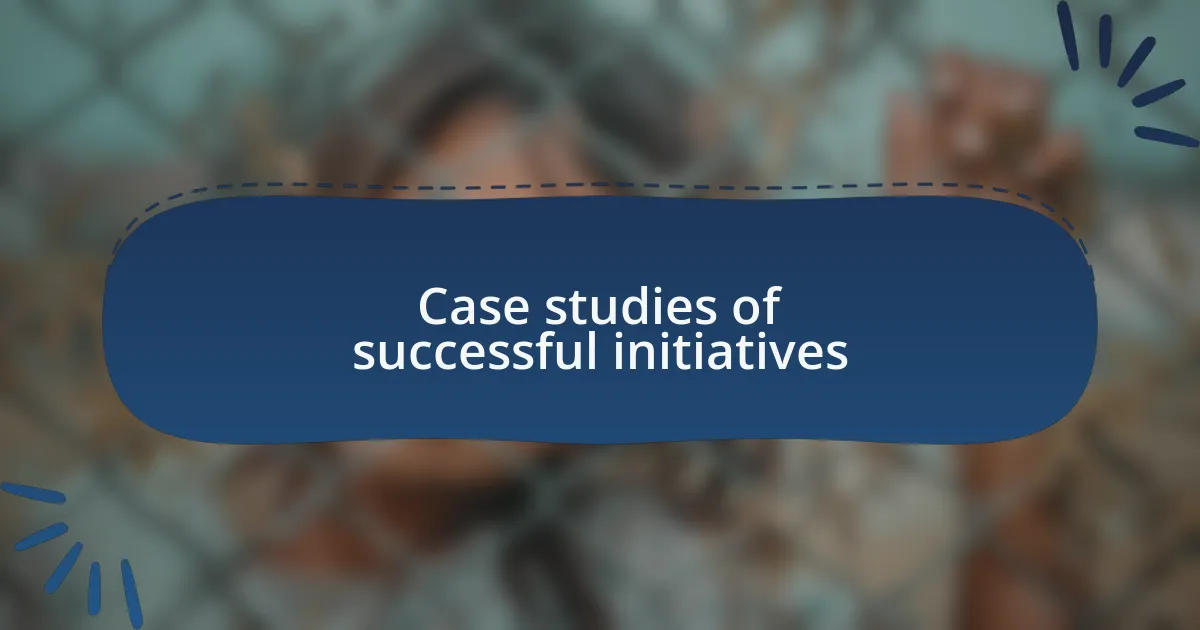
Case studies of successful initiatives
One of the most impactful initiatives I encountered was a community-based program designed to educate parents on child safeguarding practices. During a workshop, a father shared how he had unknowingly put his child at risk by not recognizing signs of emotional distress. His candidness sparked a dialogue that wasn’t just informative but deeply personal. Moments like these made me realize how vital it is to create spaces where individuals can share and learn from one another. Isn’t it incredible how a single story can resonate and alter perspectives?
In another project, we successfully collaborated with local schools to integrate safeguarding education into their curricula. I vividly recall sitting in a classroom, witnessing students actively engage in discussions about bullying and mental health. One student boldly spoke up about their experiences, leading to a collective understanding of the issue that many had previously brushed aside. This initiative taught me that empowering youths to share their stories fosters resilience and helps dismantle stigma. Can’t we all agree that children thrive in environments where their voices are heard?
Most recently, I led a multidisciplinary team focused on developing a safeguarding resource toolkit for educators. During our brainstorming sessions, we encouraged input from various stakeholders, including parents and caregivers. It was enlightening to see how their lived experiences informed our resources—making them not only practical but relatable. This collaborative effort reminded me that we are all part of the solution. How often do we forget that involving the community is crucial in creating effective safeguarding measures?
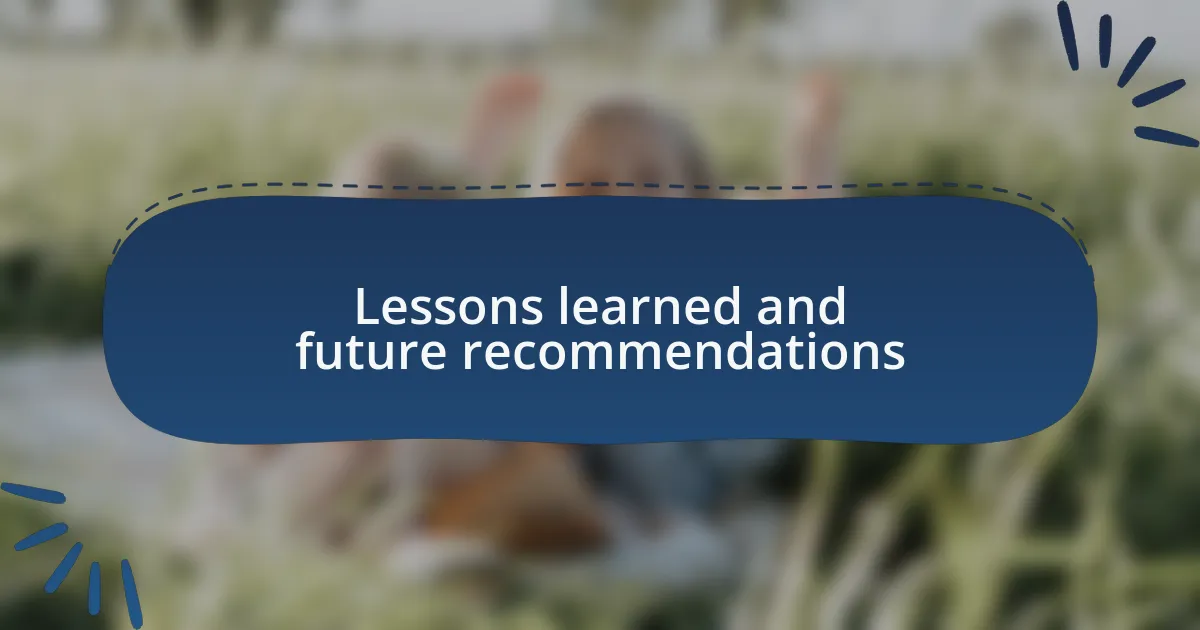
Lessons learned and future recommendations
The journey of translating policy into action has taught me that genuine engagement is non-negotiable. I recall a meeting where a lone voice expressed frustration about navigating bureaucratic procedures in accessing support for their child. This situation underscored the need for advocating clearer guidelines that empower families to access resources without feeling overwhelmed. Who wouldn’t want a more straightforward process to ensure children’s wellbeing?
Additionally, I’ve realized that continuous feedback loops are essential for refining initiatives. One time, we conducted follow-up surveys after implementing a new training program, and the insights revealed surprising gaps in understanding among staff. This experience highlighted to me that without ongoing dialogue, we risk missing crucial information that could directly impact the effectiveness of our safeguarding efforts. How can we expect progress without being open to feedback?
Looking ahead, I strongly recommend fostering partnerships with diverse community organizations to tackle safeguarding from multiple angles. In one memorable collaboration with a local art center, we organized workshops that combined creativity with discussions on safety, fostering deeper connections among participants. By embracing various perspectives and expertise, we can create holistic strategies that resonate more profoundly within our communities. Isn’t it time we explored every avenue to ensure children feel safe and supported?